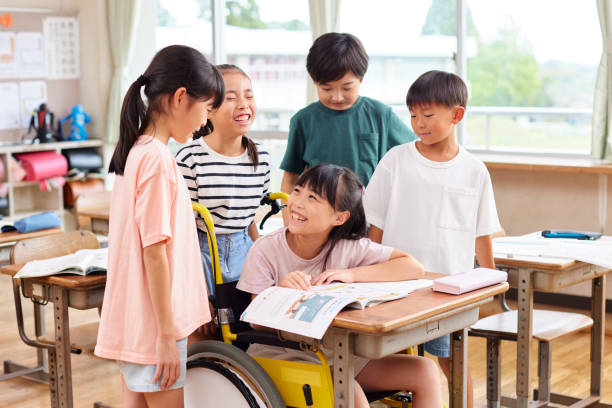Today’s classrooms are more diverse than ever. Students come from various backgrounds, speak multiple languages, and have different learning styles and abilities. That’s why Inclusive Education K–12 isn’t just a trend, it’s a necessity.
Creating inclusive classrooms means ensuring every student feels respected, represented, and supported. It’s not about treating all students the same; it’s about meeting them where they are and giving them what they need to succeed.
This guide walks you through the principles, benefits, and real-world strategies that make inclusive education not only possible but powerful.
What Is Inclusive Education in K–12?
Inclusive education is an approach that ensures students of all backgrounds and abilities learn together in the same environment, with access to high-quality teaching, support services, and opportunities.
Insight: According to UNESCO, inclusive classrooms lead to better academic and social outcomes for all students, not just those with special needs.
It includes:
- Students with disabilities
- English Language Learners (ELLs)
- Neurodiverse students (ADHD, autism, dyslexia)
- Culturally and linguistically diverse students
- LGBTQ+ and gender-diverse youth
Why Inclusive Education Matters
Embraces Diversity
- Prepares students for a globalized, multicultural world.
- Builds empathy and respect for differences.
Enhances Learning
- Differentiated instruction supports deeper understanding.
- Peer collaboration boosts engagement and social skills.
Promotes Equity
- Breaks down barriers to learning.
- Encourages high expectations for every student.
Core Principles of Inclusive Education
| Principle | What It Means in Practice |
|---|---|
| Access | All students can participate in the same curriculum. |
| Participation | Students are actively involved, not just physically present. |
| Support | Students receive the resources and accommodations they need. |
| Respect | Every student is valued for who they are. |
When schools embrace these principles, inclusive classrooms become places of growth for everyone.
Strategies for Inclusive Education K–12
1. Differentiate Instruction
Use varied teaching methods, visual, auditory, and kinesthetic, to meet diverse needs. Adjust pace, content, or outcomes based on ability and readiness.
2. Use Universal Design for Learning (UDL)
Plan lessons from the start to be flexible and accessible:
- Multiple ways to access content
- Varied formats for showing learning
- Student choice and autonomy
3. Foster a Culture of Belonging
- Learn and use students’ names correctly
- Include diverse books, stories, and voices
- Create shared classroom norms that emphasize inclusion
4. Collaborate with Support Staff
- Special educators, ESL teachers, and counselors offer insights and tools.
- Use co-teaching or push-in support models when possible.
Tech Tools for Inclusive Classrooms
Technology plays a key role in accessibility.
Top Tools:
- Text-to-speech and speech-to-text tools
- Closed captions for videos
- Immersive Reader for dyslexia-friendly formatting
- Google Translate or translation extensions for ELLs
These tools support Inclusive Education K–12 by reducing barriers and increasing independence.
Inclusive Assessment and Grading
Traditional grading often fails to capture diverse learners’ growth. Instead:
- Offer performance-based assessments (projects, portfolios)
- Allow oral responses or visual explanations
- Focus on individual progress, not just comparison
Tip: Use rubrics that prioritize growth, effort, and understanding.
Creating a Physically and Emotionally Safe Environment
Physical Space
- Flexible seating
- Accessible materials and entrances
- Quiet areas or calm-down corners
Emotional Safety
- Anti-bullying policies that protect ALL students
- Trauma-informed responses to behavior
- Restorative conversations over punitive discipline
When students feel safe, they can take risks, speak up, and learn more deeply.
The Role of Teachers in Inclusive Education
Teachers are the frontline leaders of inclusion. Here’s how they can lead:
- Model inclusive language and behavior
- Reflect on biases and check assumptions
- Create partnerships with families, especially those from underrepresented backgrounds
- Continuously learn through professional development
Success Story: Inclusion in Action
Case Example: At Lincoln Middle School, 6th graders with learning disabilities were integrated into general education classrooms using co-teaching. With differentiated instruction and technology support, the students’ reading scores improved by 25% in just one semester.
Read Also: How to Get Involved in Your Child’s School?
Conclusion
Creating truly inclusive classrooms takes effort, reflection, and commitment, but it’s worth every step. Inclusive Education K–12 ensures that all students, regardless of background or ability, feel seen, heard, and supported.
By adopting inclusive teaching strategies, embracing student diversity, and fostering a sense of belonging, we prepare every learner, not just to succeed in school, but in life.
Let’s build classrooms where every child feels like they belong because they do.
FAQs
1. What does inclusive education mean in K–12?
It means creating classrooms where all students learn together with equal access, respect, and support.
2. How is inclusion different from integration?
Inclusion involves adapting the environment to the student. Integration often means placing students in a classroom without the necessary support.
3. How can teachers support inclusive education?
By differentiating instruction, using UDL, collaborating with specialists, and fostering belonging and equity.
4. What challenges do schools face with inclusion?
Lack of training, time, and resources can hinder effective implementation, but solutions exist.
5. Why is inclusive education important for all students?
It teaches empathy, respect, and prepares students for diverse workplaces and communities.
